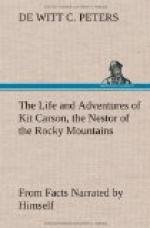bushes, etc., the task was imperfectly gone through
with. The Mexican axe is another curious tool,
which resembles as much the common pick of our laborers
as it does the axe used by American woodsmen.
The sickle is used in harvesting to this day in these
parts, performing the duties of the scythe, the cradle,
etc. The most remarkable sight of all is
the Mexican cart, the noise of which, when moving,
can, be heard on a still day at a great distance.
The wheels of this vehicle are at least one foot thick,
and consist of pieces of solid wood which are pegged
together and made to approach a circle by the best
judgment of the eye, without the aid of measuring.
These wheels are very heavy, and when rolling they
go by jerks, owing to their want of proportion, etc.
The body of the cart, as are all of its parts, is made
of soft wood, and seems to be constructed for weight
and strength instead of beauty. The whole affair,
when complete, is almost a load by itself; hence, it
is capable of carrying but a small cargo. The
grain that Mexicans of New Mexico grow is corn and
wheat, and it is on these crops that they depend for
their support. In converting this grain into flour,
they either use the old water mill which is very primitive
in its construction, or else, when these are not near
by, they make use of two stones and grind it by hand.
Their common diet is a sort of thick gruel made of
corn meal, wheat bread, eggs, peas, beans, pumpkins,
which latter articles they roast, and then break holes
into them and with a spoon dip out the contents as
they are required; and, to finish the catalogue, sometimes
meat, game and milk. The fruits found in New
Mexico are not various, and are mostly confined to
apples, peaches, plums and grapes. These latter
are truly superior, and are raised in the greatest
abundance in the south of the Territory, where, also,
they manufacture a very pleasant red wine, which goes
by the name of El Paso Wine. We take the manners
and customs of the people of Taos as a good type to
judge of the manners and customs of the New Mexicans,
for the town is second only in size, in this Territory,
to Santa Fe. The inhabitants of New Mexico, notwithstanding
their poverty and neglect, owing to their remote locality,
are perhaps as happy and contented as any community
in the world. They are not over-celebrated for
their chastity or virtue; and, to the disgrace of the
white man, they have not been assisted by him in these
cardinal principles; but, time will work wonders on
this score and teach the immorality of such proceedings.
Their great source of enjoyment consists in dancing;
and hence the fandango is always looked for as a time
when dull care will be dispelled. A grand fandango
is the event of a New Mexican’s life. These
affairs are gotten up sometimes for charitable purposes,
when the money gathered in the sale of refreshments
is distributed to the poor; or else they are started
by individuals to make a little money out of.




